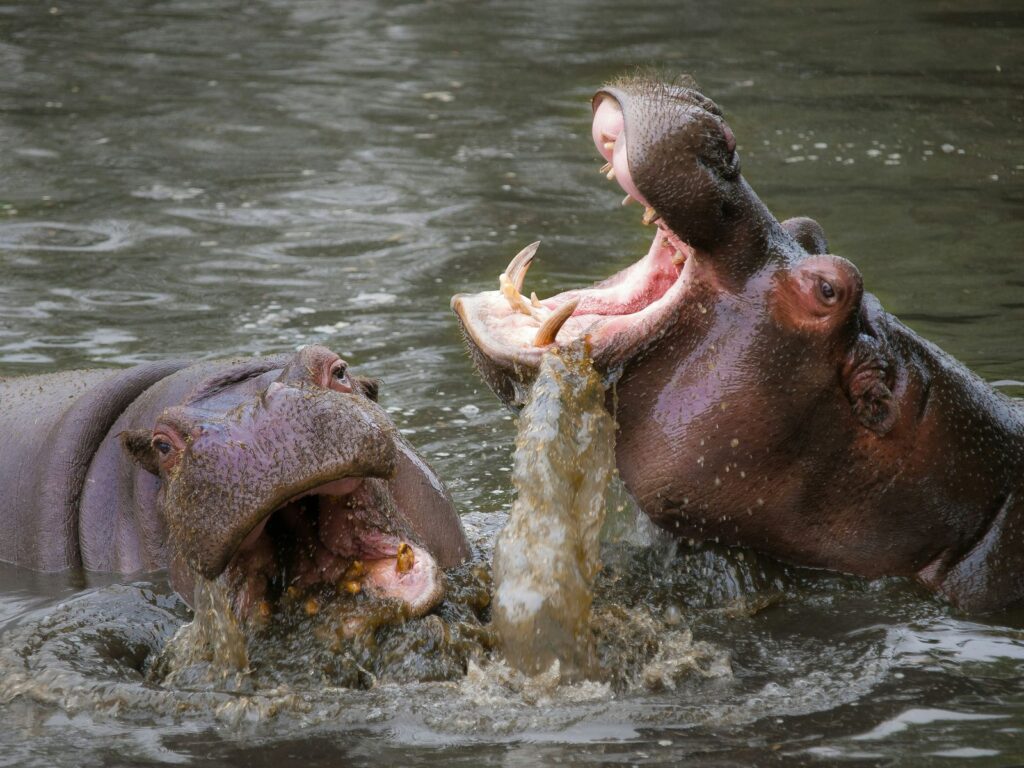Hippos can be highly aggressive animals, especially in their aquatic environments, where they are most territorial.
In particular, male hippos can show highly aggressive behaviour when defending their territory. Hippo and human conflicts are possible and can lead to potential hippo attacks.
Hippos are responsible for killing many people in Africa, though their exact death toll compared to other animals like elephants is debated. When hippos attack, the likelihood of death is particularly high, with 87% of hippo attacks on humans resulting in fatalities. This rate is higher than that of lion attacks (75%) and elephant attacks (67%).
Hippos kill people primarily in accidental encounters on land or in water, particularly when humans come too close, provoke them, or surprise them while fishing or farming near water sources.
Hippos are herbivores, so they don’t hunt other animals, but their aggression is usually in defence of territory, mates, or their young. Their surprising speed on land and water, combined with their massive size and jaw strength, makes them one of the most dangerous animals in Africa. Even predators like lions and crocodiles tend to avoid conflicts with them unless necessary.
Main Takeaways
- Aggressive Behavior: Hippos can be aggressive, particularly in water, and are very territorial, especially male hippos.
- Human-Hippo Conflict: Human-hippo encounters can lead to attacks, often fatalities. Hippos are responsible for many human deaths in Africa, with an 87% fatality rate in attacks.
- Physical Strength: Hippos possess powerful jaws, teeth up to 50 cm long, and surprising speed on land and water, making them one of Africa’s most dangerous animals.
- Territoriality: Male hippos defend their territories aggressively, especially during mating seasons and resource-scarce periods, using defecation to mark boundaries.
- Human Risk Areas: People near water sources, like fishermen and farmers, are particularly vulnerable to hippo attacks due to accidental encounters.
- Conflict Mitigation: Strategies include direct methods like barriers and translocation, as well as indirect methods like community education, compensation for losses, and conservation efforts.
- Conservation Balance: A combined approach of deterrents and conservation is necessary to minimise conflicts while protecting both human lives and hippo populations.

Hippo Physical Traits
The physical traits of hippos result from remarkable adaptations to both land and aquatic environments. They are the second largest land animal after elephants and possess various characteristics that enable them to thrive in both settings.
Males can weigh between 1,600 and 3,200 kg, while females range from 650 to 2,350 kg. Their short, sturdy legs support their massive bulk, and their broad frame is capped with a large head.
One of the most striking features of hippos is their powerful jaws, equipped with teeth that can grow up to 50 cm long. They have a high set of nostrils that permit breathing while mostly submerged.
Aggressive Water Behavior
Hippos are primarily herbivorous, and they feed in grassland areas around watercourses. However, they spend a long time in the water, where their aggressive and territorial behaviour can be marked.
With the ability to run underwater at up to 8 km/h (5 mph) speeds, hippos can easily outpace many swimmers. We often see hippos just coming out from the water’s surface with only their eyes and nostrils; their high-set nostrils allow them to remain mostly submerged.
However, even in water, hippos attack only when they feel threatened or cornered. Activities such as fishing or boating can inadvertently provoke these aggressive responses.
Territorial Aggression
Hippos are often seen as docile herbivores and grazing areas around watercourses, especially at night. However, territorial aggression is a defining aspect of their behaviour. This aggression is primarily observed in male hippos, who assert dominance and defend their territory against threats, including humans and other animals.
Territorial claims are communicated through defecation, which hippos use to mark boundaries and deter intruders. The intensity of these behaviours is especially pronounced during the mating season when male hippos display, when male rivals are present, their tusks and teeth to intimidate and secure their domain.

During the dry season, territorial aggression among hippos can be intense due to the scarcity of resources, leading to increased conflicts over territory.
These factors make hippos formidable guardians of their territories, warranting respect and caution from those who venture too close to their domains.
Human Encounters
Human-hippo conflicts arise when hippos threaten human lives or livelihoods, especially near water sources. These encounters often result in property damage, injury, or even death.
Hippos attack when they feel threatened, particularly when humans accidentally come too close or attempt to move them from crops. Fishing communities are particularly vulnerable, as hippos can become entangled in nets or damage boats.
Though not the deadliest animals, hippo attacks are highly fatal, with an 87% death rate in some regions. In retaliation, people often kill hippos, jeopardising their survival and even pushing hippos towards a decline in numbers. The growing human population exacerbates this cycle of conflict and retributive killing, and efforts to mitigate this could include community-based conservation projects.
Human Hippo Conflict Mitigations
Mitigating human-hippo conflicts is extremely important and requires a mix of direct and indirect approaches.
Direct methods
Physical barriers, such as strong fences or trenches, can prevent hippos from entering agricultural areas, reducing human-hippo encounters without harming the animals.
Non-lethal methods like translocation should be used cautiously due to the cost and risks involved, while repellents like lights and noise can offer temporary protection, though hippos may adapt.
Establishing riparian buffer zones – protected areas near water bodies where hippos primarily reside – can create safe zones that reduce conflict while preserving their habitat.
Indirect Methods
Indirect approaches promote coexistence, such as crop or livestock loss compensation, community-based conservation, and education. Revenue sharing from ecotourism and hunting can also incentivise local communities to protect hippos.
This approach minimises danger to people and ensures the conservation of hippo populations.
A combined approach tailored to specific contexts offers the best chance to mitigate HHC effectively.
Minimising dangers to humans while protecting hippos requires a balanced strategy that combines effective deterrents and conservation efforts.
Conclusions
While hippos are often perceived as docile herbivores, their aggressive nature poses risks to human populations and hippos alike living near aquatic environments.
The high fatality rate associated with hippo attacks heightened awareness and caution when interacting with these creatures.
Their physical strength and adaptations enable them to thrive in terrestrial and aquatic settings, making them powerful guardians of their territory.
Comprehensive mitigation strategies with direct and indirect methods are essential to address the conflicts between humans and hippos. Establishing physical barriers, promoting coexistence through community engagement, and utilising conservation initiatives are all methods that can reduce the incidence of human-hippo encounters while simultaneously ensuring the survival of hippo populations.
A balanced approach that prioritises safety for local communities and the conservation of wildlife will be crucial in fostering a harmonious coexistence between humans and hippos, thereby protecting both lives and ecosystems.



